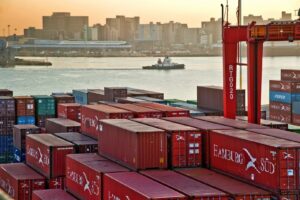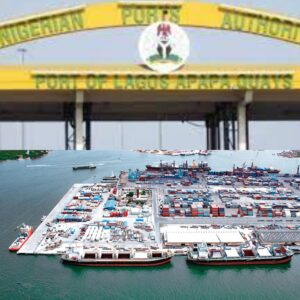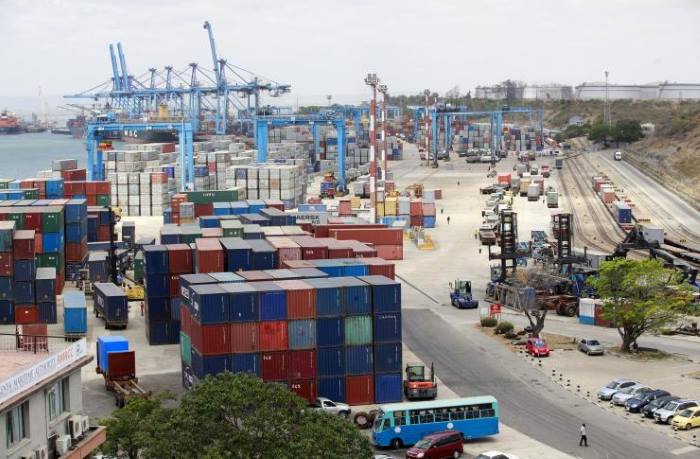With Africa as a developing continent, port activities, no doubt, play critical role in stimulating economic growth.
Ports, apart from contributing to economic development within the continent, also serve as strategic routes for global trade.
Join our WhatsApp ChannelThe United Nations Conference on Trade and Development (UNTAD)’s Review of Maritime Transport 2021 noted that implementation of the African Continental Free Trade Area (AfCFTA) Agreement has great potentials for boosting maritime trade and transport in Africa, given the abundance of natural resources that could drive economic activities for imports and exports.
However, as experts say, the challenge lies in poor maritime infrastructure across the continent.
In this article, we highlight 7 major ports powering economies in Africa.
1. Port of Durban, South Africa

The Port of Durban, commonly called “Durban Harbour,” is considered one of the biggest and busiest shipping terminals in Africa, lying on the eastern coastline of South Africa.
Having 58 berths managed by over 22 port operators, the Durban Port has the 4th largest container facility in the Southern Hemisphere and is estimated to accommodate processing of approximately 32 million tonnes of cargo and 4.5 million Twenty foot Equivalent (TEUs) annually.
Statistically, it is estimated to generate about 60 per cent of trade revenue for South Africa and is visited by more than 5000 ships every year.
The facility has shipping links to Europe, South and North America, Australia, the Middle East and Far East Asia. It also serves as a crucial transhipment hub for the eastern African region and the Indian Ocean Islands.
2. Dar-es-Salaam Port, Tanzania
The Port of Dar-es-Salaam is the major port serving Tanzania. The port is one of three ocean ports in the country handling over 90 per cent of the country’s cargo traffic annually.
According to the International Association of Ports and Harbors, it is the fourth largest port on the African continent’s Indian Ocean coastline after Durban in South Africa, Mombasa in Kenya and Maputo in Mozambique.
Located in a natural, well-sheltered harbour, the East Africa port consists of 11 deepwater berths stretching to 2,600m. It serves landlocked nations like Congo, Malawi, Burundi, Uganda and Zambia and also connected to major ports in the Middle East, Europe, America and Australia.
The port has seven general cargo berths for handling break-bulk, roro and dry cargo and also two oil terminals for receiving oil vessels (both crude and refined oil).
3. Port of Lagos, Nigeria

The port, located in Lagos, is the earliest and largest Port in Nigeria’s 853-kilometre long coastline facing the Atlantic ocean.
Situated in the Bight of Benin, it includes the ports of Apapa and Tin Can Island, operated by the Nigerian Ports Authority (NPA).
Established in 1913 during colonial period, the port began operations with the construction of the four deepwater wharves in 1921. The Port also has two Logistics bases- Eko Support Services Ltd. and Lagos Deep Offshore Logistics (LADOL) and eight jetties.
Presently, the port is one of the most efficient ports in Nigeria, equipped with modern equipment and the latest operating systems for providing cost-effective services to its national and international customers.
The Port Complex houses five private terminals operated by AP Moller, ENL Consortium Limited, Apapa Bulk Terminal, Greenview Development Nigeria Ltd and Lilypond Inland Terminal. These specialised facilities have more than 10 berths for handling cereals, grains, machinery, construction material, and perishable items like foodstuff, minerals, fertilisers, flour, salt, sugar etc. Two flour mills and a processing plant are present in the port premises, close to the bulk terminals.
The Apapa container terminal is one of the largest container terminals in West Africa, operated by AP Moller. It has an annual container capacity of over 1,000,000 TEUs and is equipped with 13 mobile harbour cranes.
4. Port of Beira, Mozambique
The port of Beira in Mozambique, situated at the mouth of the Pungue River, is considered one of the most modern terminals in southern Africa.
The port is an important centre for shipping and logistics in the central Mozambican and Central African regions, while also serving as a gateway to the neighbouring African states by road, rail and pipeline to Zimbabwe, and road and rail to Botswana, Zambia, DR Congo, and Malawi. The city of Beira is the third largest in Mozambique.
The port has 11 berths extending along 1,994 metres of quayside, excluding berth 1 which is reserved for fishing vessels.
It has a 10,000 TEU storage capacity and 148 reefer connections. Presently, the terminal is estimated to handle around 300,000 TEUs annually. Its total container throughput stood at 255,459 TEUs in 2020.
It has general or multipurpose cargo terminal, container and grain terminals.
5. Suez Port, Egypt
Suez Port is one of the biggest ports in Egypt located at the southern boundary of the Suez Canal.
The port has three harbours, namely the Abadiya, Ain Sokhna Port and Tawfiq Port which are part of the Suez metropolitan area. With approximately 2,500,000 Twenty-foot Equivalent Unit (TEU), the facility receives more than 2000 ships annually.
Historically, the port has been a trading post since the 7th century, fed by an ancient canal system stretching from the Nile delta to the Suez Gulf.
The port connects neighbouring cities of Cairo and Port Said through railways and highways and has facilities for accommodating general cargo ships and passenger’s vessels.
It has separate habours for oil tankers, livestock and fishery.
6. Port of Mombasa, Kenya
Mombasa is a large coastal city in Kenya, and second largest city in the East African country.
The port which lies on the southeastern Indian Ocean coastline, is the leading international seaport of Kenya.
Mombasa Port which has been a trading hub since medieval times, boomed in the 18th century with the arrival of Portuguese and Arab explorers who engaged in spice and slave trade.
Mombasa Port has undergone series of transformation over the years which include construction of more terminals and berths to play critical role in economic development of the country.
The port includes the Kilindini Harbour, the old port area and subsidiary ports of Reitz and Tudor. Presently, the main port comprises 19 berths divided among a bulk terminal, two oil terminals, four container wharves and 12 conventional docks.
Currently, Mombasa Port is well equipped for processing varied cargo types, including dry cargo like fertilisers, grains, cement, and soda ash; liquid bulk such as crude oil and petroleum; bagged products including coffee, tea, and sugar.
The port serves not only Kenya but also handles the maritime trade of inland African countries like Ethiopia, Burundi, Uganda, Rwanda, eastern Congo, and South Sudan. It is also directly linked with some countries in Western Europe, America and Asia ports. Its regular feeder services connect Mombasa to Dar-es-salaam, Mogadishu, Durban and Dubai.
The port ranks as the 24th most extensive container facility globally, linked to over 180 ports across 70 countries.
According to Kenya Ports Authority, the Port of Mombasa handled 9.54 million tons in the first quarter of the year 2021 compared to 8.62 million tons in a similar period.
7. Port of Tanger Med, Morocco
Tanger Med Port which was opened in 2007, is a deep-water port.
It is the largest port in the north African country, located on the Strait of Gibraltar, about 40 kilometres from the city of Tangier in northern Morocco.
The port which is currently undegoing expansion to accommodate modern logistical network involved in global trade, has two container terminals, a RORO terminal, grain handling facilities and a passenger port.
It handles more than half of the international maritime trade of Morocco and is the busiest port in the north African country.
Victor Ezeja is a passionate journalist with six years of experience writing on economy, politics and energy. He holds a Masters degree in Mass Communication.


















Follow Us